标签:
UITableView:表格视图控件,继承滚动视图控件UIScrollView,(类似于UIPickerView选择器,它主要通过设置数据源代理和行为代理实现协议来设置单元格)
@interface UITableView : UIScrollView <NSCoding>
@property (nonatomic, readonly) UITableViewStyle style;//表格样式
@property (nonatomic, assign) id <UITableViewDataSource> dataSource; //数据源代理
@property (nonatomic, assign) id <UITableViewDelegate> delegate;//操作代理
@property (nonatomic) CGFloat rowHeight; //行高
@property (nonatomic) CGFloat sectionHeaderHeight;//组表头高度
@property (nonatomic) CGFloat sectionFooterHeight; //组表尾高度
@property (nonatomic) CGFloat estimatedRowHeight ; //行评估高度
@property (nonatomic) CGFloat estimatedSectionHeaderHeight ;//组表头评估高度
@property (nonatomic) CGFloat estimatedSectionFooterHeight ;//组表尾评估高度
@property (nonatomic) UIEdgeInsets separatorInset;//分离矩形区域
@property(nonatomic, readwrite, retain) UIView *backgroundView //背景视图
@end
2.基本方法:
- (instancetype)initWithFrame:(CGRect)frame style:(UITableViewStyle)style; //初始化
- (NSInteger)numberOfSections; //组数
- (NSInteger)numberOfRowsInSection:(NSInteger)section; //某一组行数
- (CGRect)rectForSection:(NSInteger)section; //某一组的矩形区域
- (CGRect)rectForHeaderInSection:(NSInteger)section;//某一组的表头矩形区域
- (CGRect)rectForFooterInSection:(NSInteger)section;//某一组表尾矩形区域
- (CGRect)rectForRowAtIndexPath:(NSIndexPath *)indexPath;//某一组某行的矩形区域
- (NSIndexPath *)indexPathForRowAtPoint:(CGPoint)point; //返回指定表单元的NSIndexPath路径信息
- (NSIndexPath *)indexPathForCell:(UITableViewCell *)cell; // 返回指定表单元的NSIndexPath路径信息
- (NSArray *)indexPathsForRowsInRect:(CGRect)rect; // 返回指定CGRect的NSIndexPath路径信息数组
- (UITableViewCell *)cellForRowAtIndexPath:(NSIndexPath *)indexPath; //返回某组某一行的单元格
- (NSArray *)visibleCells;//返回可见单元格数组
- (NSArray *)indexPathsForVisibleRows;//返回可见行的索引数组
- (UITableViewHeaderFooterView *)headerViewForSection:(NSInteger)section ;//返回某一组表头视图
- (UITableViewHeaderFooterView *)footerViewForSection:(NSInteger)section ;//返回某一组表尾视图
- (void)scrollToRowAtIndexPath:(NSIndexPath *)indexPath atScrollPosition: (UITableViewScrollPosition)
scrollPosition animated:(BOOL)animated;//将单元格滑动到指定位置的行
- (void)scrollToNearestSelectedRowAtScrollPosition:(UITableViewScrollPosition)scrollPosition animated:(BOOL)animated;//将单元格滑动到选中的行
- (UITableViewCellAccessoryType)tableView:(UITableView *)tableView accessoryTypeForRowWithIndexPath:(NSIndexPath *)indexPath //返回标记效果类型
Plain类型:
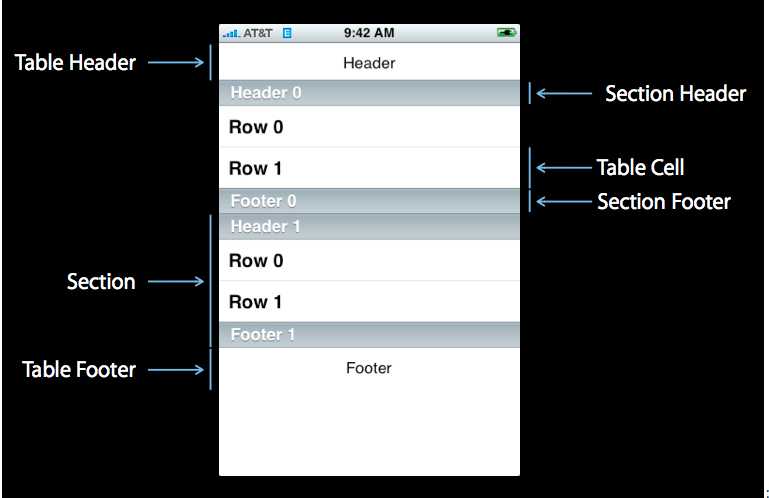

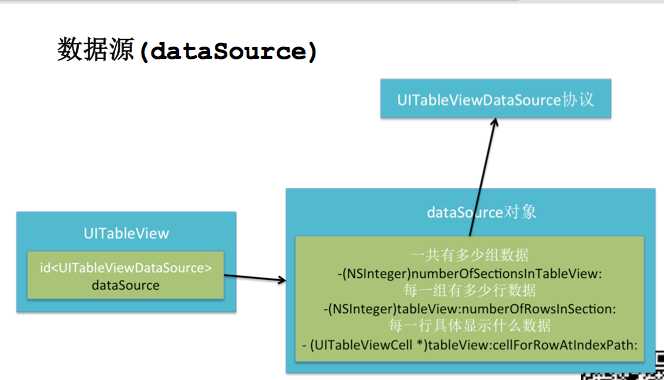

UITableViewStylePlain, // 规则的表格式图
UITableViewStyleGrouped //分组的表格视图
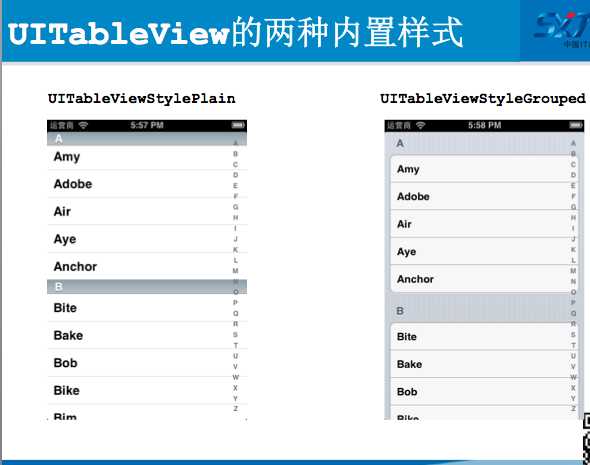
4.标记单元格Cell (对选中的单元格做处理的显示方式)
标记分别有四种效果:
UITableViewCellAccessoryCheckmark //单元格右边每条记录后面打上对勾
UITableViewCellAccessoryDetailDisclosureButton //单元格右边带箭头的小圆按钮,可以添加事件
UITableViewCellAccessoryDisclosureIndicator//展开指示器,相当于内容被折叠起来后可以打开
UITableViewCellAccessoryNone//没有任何的样式
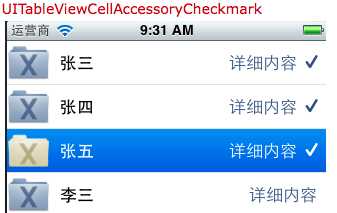
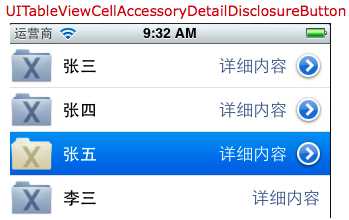
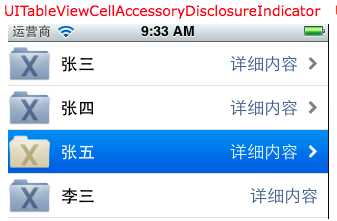
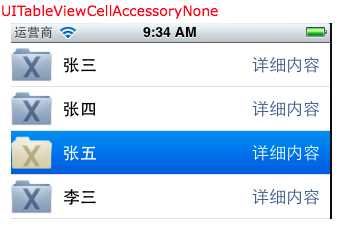
5.对单元格的编辑三种类型:
UITableViewCellEditingStyleDelete //删除选中的单元格
UITableViewCellEditingStyleInsert//插入新的单元格
UITableViewCellEditingStyleNone//移动单元格
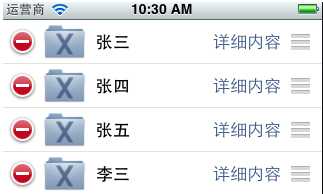
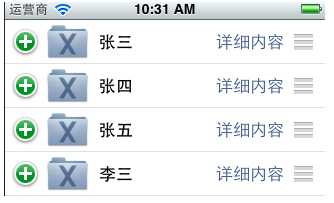

6.在删除和添加单元格的用到UITableViewRowAnimation几种动画刷新效果
UITableViewRowAnimationAutomatic //单元格按自动方式滑入/出
UITableViewRowAnimationTop //单元格滑动到相邻单元格之上
UITableViewRowAnimationBottom //单元格滑动到相邻单元格之下
UITableViewRowAnimationLeft //单元格往左滑入/出
UITableViewRowAnimationRight //单元格往右滑入/出
UITableViewRowAnimationMiddle // 单元格往中间滑入/出
UITableViewRowAnimationFade //单元格淡入/出
UITableViewRowAnimationNone //没有动画效果
7.UITableView提供了4种基本的表格视图单元格,在SDK 3.0 之后,每个单元格都有3个属性textLabel(主标题),detailTextLabel(副标题)和imageView(图像视图)。
下面一一介绍这4种基本单元格类型格式:
<1>UITableViewCellStyleDefault
该格式提供了一个简单的左对齐的文本标签textLabel和一个可选的图像imageView。如果显示图像,那么图像将在最左边。
这种格式虽然可以设置detailTextLabel,但是不会显示该标签。
<2>UITableViewCellStyleSubtitle
该格式与前一种相比,增加了对detailTextLabel的支持,该标签将会显示在textLabel标签的下面,字体相对较小。
<3>UITableViewCellStyleValue1
该格式居左显示textLabel,居右显示detailTextLabel,且字体较小。
该格式不支持图像。
<4>UITableViewCellStyleValue2
该格式居左现实一个小型蓝色主标签textLabel,在其右边显示一个小型黑色副标题详细标签detailTextLabel。
该格式不支持图像
二、表格视图的数据源协议:UITableViewDataSource
@protocol UITableViewDataSource<NSObject>
@required
//设置每组多少行
- (NSInteger)tableView:(UITableView *)tableView numberOfRowsInSection:(NSInteger)section;
//设置每一行的单元格
- (UITableViewCell *)tableView:(UITableView *)tableView cellForRowAtIndexPath:(NSIndexPath *)indexPath;
@optional
//设置有多少组
- (NSInteger)numberOfSectionsInTableView:(UITableView *)tableView;
//设置表头内容
- (NSString *)tableView:(UITableView *)tableView titleForHeaderInSection:(NSInteger)section;
//设置表尾内容
- (NSString *)tableView:(UITableView *)tableView titleForFooterInSection:(NSInteger)section;
//设置编辑状态(某一行是否可以编辑(删除))
- (BOOL)tableView:(UITableView *)tableView canEditRowAtIndexPath:(NSIndexPath *)indexPath;
//设置移动状态(某一行是否可以移动来进行重新排序)
- (BOOL)tableView:(UITableView *)tableView canMoveRowAtIndexPath:(NSIndexPath *)indexPath;
//右边的索引栏的内容
- (NSArray *)sectionIndexTitlesForTableView:(UITableView *)tableView;
//根据单元格索引和内容返回组索引
- (NSInteger)tableView:(UITableView *)tableView sectionForSectionIndexTitle:(NSString *)title atIndex:(NSInteger)index;
//对指定的组、行的单元格执行编辑操作(增加、删除、插入)
- (void)tableView:(UITableView *)tableView commitEditingStyle:(UITableViewCellEditingStyle)editingStyle forRowAtIndexPath:(NSIndexPath *)indexPath;
//对指定的组、行的单元格执行移动操作
- (void)tableView:(UITableView *)tableView moveRowAtIndexPath:(NSIndexPath *)sourceIndexPath toIndexPath:(NSIndexPath *)destinationIndexPath;
@end
三、//NSIndexPath
@interface NSIndexPath (UITableView)
+ (NSIndexPath *)indexPathForRow:(NSInteger)row inSection:(NSInteger)section;
@property(nonatomic,readonly) NSInteger section; //组
@property(nonatomic,readonly) NSInteger row;//行
@end
四、表格视图的行为协议:UITableViewDelegate
@protocol UITableViewDelegate<NSObject, UIScrollViewDelegate>
@optional
//选择某一行单元格开始时
- (void)tableView:(UITableView *)tableView willDisplayCell:(UITableViewCell *)cell forRowAtIndexPath:(NSIndexPath *)indexPath;
//选择某一组表头视图开始时
- (void)tableView:(UITableView *)tableView willDisplayHeaderView:(UIView *)view forSection:(NSInteger)section ;
//选择某一组表尾视图开始时
- (void)tableView:(UITableView *)tableView willDisplayFooterView:(UIView *)view forSection:(NSInteger)section;
//选择某一行单元格开始时
- (void)tableView:(UITableView *)tableView didEndDisplayingCell:(UITableViewCell *)cell forRowAtIndexPath:(NSIndexPath*)indexPath ;
//选择某一组表头视图结束时
- (void)tableView:(UITableView *)tableView didEndDisplayingHeaderView:(UIView *)view forSection:(NSInteger)section ;
//选择某一组表尾视图结束时
- (void)tableView:(UITableView *)tableView didEndDisplayingFooterView:(UIView *)view forSection:(NSInteger)section;
//选中了UITableView的某一行
- (void)tableView:(UITableView *)tableView didSelectRowAtIndexPath:(NSIndexPath *)indexPath;
//取消了UITableView的某一行
- (void)tableView:(UITableView *)tableView didDeselectRowAtIndexPath:(NSIndexPath *)
//返回某一行的高度
- (CGFloat)tableView:(UITableView *)tableView heightForRowAtIndexPath:(NSIndexPath *)indexPath;
//返回某一组表头的高度
- (CGFloat)tableView:(UITableView *)tableView heightForHeaderInSection:(NSInteger)section;
//返回某一组表尾的高度
- (CGFloat)tableView:(UITableView *)tableView heightForFooterInSection:(NSInteger)section;
//显示某一组表尾的视图
//设置每一行的等级缩进(数字越小,等级越高)
//返回单元格的编辑类型
-(UITableViewCellEditingStyle)tableView:(UITableView *)tableView editingStyleForRowAtIndexPath:(NSIndexPath *)indexPath
@end
重点:获取indexPath的三种方式
//1.通过标记tag获取
//1.1通过按钮的tag获取indexPath
//Product *product = [self.products objectAtIndex:sender.tag];
//1.2通过拿出按钮的父视图的父视图获取单元格
//shopingTableViewCell *cell = (shopingTableViewCell*)sender.superview.superview;(button->contentView->cell)
//NSIndexPath *indexPath = [self.tableView indexPathForCell:cell];
//Product *product = [self.products objectAtIndex:indexPath.row];
//1.3通过event记录的触摸点获取indexPath
UITouch *touch = [[event allTouches] anyObject];
CGPoint point = [touch locationInView:self.tableView];
NSIndexPath *indexPath = [self.tableView indexPathForRowAtPoint:point];
范例一:制作一个水果分组表格
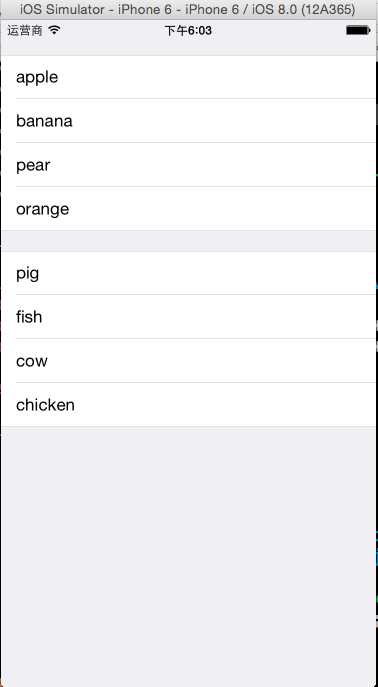
1 #import "ViewController.h"
2
3 @interface ViewController ()<UITableViewDataSource>
4 @property (weak, nonatomic) IBOutlet UITableView *tableView;
5 @property (strong,nonatomic)NSArray *fruit;
6 @property (strong,nonatomic)NSArray *meat;
7
8 @end
9
10 @implementation ViewController
11
12 - (void)viewDidLoad {
13 [super viewDidLoad];
14 //初始化数据
15 self.fruit = [NSArray arrayWithObjects:@"apple",@"banana",@"pear",@"orange",nil];
16 self.meat = [NSArray arrayWithObjects:@"pig",@"fish",@"cow",@"chicken", nil];
17
18 //设置tableView的数据源代理dataSource
19 self.tableView.dataSource = self;
20 }
21
22 #pragma mark - tableView的数据源方法
23 //设置有多少组
24 -(NSInteger)numberOfSectionsInTableView:(UITableView *)tableView
25 {
26 return 2;
27 }
28 //设置每组多少行
29 -(NSInteger)tableView:(UITableView *)tableView numberOfRowsInSection:(NSInteger)section
30 {
31 return section==0?[self.fruit count]:[self.meat count];
32 }
33 //设置每一行的单元格
34 -(UITableViewCell *)tableView:(UITableView *)tableView cellForRowAtIndexPath:(NSIndexPath *)indexPath
35 {
36 UITableViewCell *cell = [[UITableViewCell alloc]initWithStyle:UITableViewCellStyleDefault reuseIdentifier:nil];
37
38 cell.textLabel.text = indexPath.section==0?self.fruit[[indexPath row]]:self.meat[[indexPath row]];
39
40 return cell;
41 }
42 @end
范例二:制作一个中国城市表格
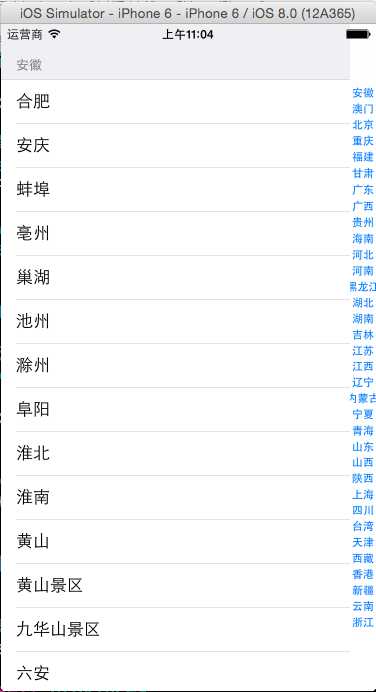
1 #import "ViewController.h"
2
3 @interface ViewController ()<UITableViewDataSource>
4 @property (strong,nonatomic)UITableView *tableView;
5 @property (strong,nonatomic)NSArray *provinces;
6 @property (strong,nonatomic)NSDictionary *cities;
7 @end
8
9 @implementation ViewController
10
11 - (void)viewDidLoad {
12 [super viewDidLoad];
13 //初始化数据
14 NSBundle *bundle = [NSBundle mainBundle];
15 NSString *path = [bundle pathForResource:@"cities" ofType:@"plist"];
16 NSDictionary *dictionary = [NSDictionary dictionaryWithContentsOfFile:path];
17 if(dictionary)
18 {
19 self.provinces = [dictionary objectForKey:@"provinces"];
20 self.cities = [dictionary objectForKey:@"cities"];
21 }
22
23 //创建UITableView,设置数据源
24 self.tableView = [[UITableView alloc]initWithFrame:self.view.frame style:UITableViewStyleGrouped];
25
26 self.tableView.dataSource = self;
27
28 [self.view addSubview:self.tableView];
29 }
30
31 #pragma mark -tableView数据源方法
32 //有多少个section
33 -(NSInteger)numberOfSectionsInTableView:(UITableView *)tableView
34 {
35 return self.provinces.count;
36 }
37 //每个section有多少个row
38 -(NSInteger)tableView:(UITableView *)tableView numberOfRowsInSection:(NSInteger)section
39 {
40 //取出某省的所有城市
41 NSArray *citiesOfProvince = [self.cities objectForKey:self.provinces[section]];
42 return citiesOfProvince.count;
43 }
44 //设置每一个单元格的内容
45 -(UITableViewCell *)tableView:(UITableView *)tableView cellForRowAtIndexPath:(NSIndexPath *)indexPath
46 {
47 //1.根据reuseIdentifier,先到对象池中去找重用的单元格对象,重用单个页面显示的所有单元格,节约内存
48 static NSString *reuseIdentifier = @"cityCell";
49 UITableViewCell *cell = [self.tableView dequeueReusableCellWithIdentifier:reuseIdentifier];
50 //2.如果没有找到,自己创建单元格对象
51 if(cell == nil)
52 {
53 cell = [[UITableViewCell alloc]initWithStyle:UITableViewCellStyleDefault reuseIdentifier:reuseIdentifier];
54 NSLog(@"创建单元格对象");
55 }
56 //3.设置单元格对象的内容
57 //取出某省的所有城市
58 NSArray *citiesOfProvince = [self.cities objectForKey:self.provinces[[indexPath section]]];
59
60 //设置单元格的内容为相应的城市的名称
61 cell.textLabel.text = [citiesOfProvince objectAtIndex:[indexPath row]];
62
63 return cell;
64 }
65
66 //设置每一个section头部的名称,设置省的名字
67 -(NSString *)tableView:(UITableView *)tableView titleForHeaderInSection:(NSInteger)section
68 {
69 return [self.provinces objectAtIndex:section];
70 }
71
72 //添加右边的索引,便于查找对应的省
73 -(NSArray*)sectionIndexTitlesForTableView:(UITableView *)tableView
74 {
75 return self.provinces;
76 }
77
78 @end
范例三 制作带有图像、主标题、副标题的通讯录

1 #import "ViewController.h"
2 #import "Contact.h"
3 #define CONTACT_NUM 20
4 @interface ViewController ()<UITableViewDataSource,UITableViewDelegate,UIAlertViewDelegate>
5 @property (strong,nonatomic)UITableView *tableView;
6 @property (strong,nonatomic)NSArray *contacts;
7 @end
8
9 @implementation ViewController
10
11 - (void)viewDidLoad {
12 [super viewDidLoad];
13 //初始化联系人信息
14 NSMutableArray *arrayM = [NSMutableArray arrayWithCapacity:CONTACT_NUM];
15 for(int i=0; i<CONTACT_NUM; i++)
16 {
17 Contact *contact = [[Contact alloc]initWithName:[NSString stringWithFormat:@"name%d",i+1] andTel:[NSString stringWithFormat:@"1861010%04d",arc4random_uniform(10000)] andFaceName:[NSString stringWithFormat:@"%d.png",arc4random_uniform(9)]];
18 [arrayM addObject:contact];
19 }
20 self.contacts = arrayM;
21
22 //创建tableView
23 self.tableView = [[UITableView alloc]initWithFrame:self.view.frame style:UITableViewStylePlain];
24
25 self.tableView.dataSource = self;
26 self.tableView.delegate = self;
27
28 [self.view addSubview:self.tableView];
29 }
30
31 #pragma mark -tableView的数据源方法
32
33 //每个组section有多少row
34 -(NSInteger)tableView:(UITableView *)tableView numberOfRowsInSection:(NSInteger)section
35 {
36 return self.contacts.count;
37 }
38 //设置每一个单元格的内容
39 -(UITableViewCell *)tableView:(UITableView *)tableView cellForRowAtIndexPath:(NSIndexPath *)indexPath
40 {
41 //1.根据reuseIdentifier,先到对象池中去找重用的单元格对象
42 static NSString *reuseIdentifier = @"contactCell";
43 UITableViewCell *cell = [self.tableView dequeueReusableCellWithIdentifier:reuseIdentifier];
44 //2.如果没有找到,自己创建单元格对象
45 if(cell == nil)
46 {
47 cell = [[UITableViewCell alloc]initWithStyle:UITableViewCellStyleSubtitle reuseIdentifier:reuseIdentifier];
48 }
49 //3.设置单元格对象的内容
50 Contact *contact = [self.contacts objectAtIndex:indexPath.row];
51 //设置头像
52 [cell.imageView setImage:[UIImage imageNamed:contact.faceName]];
53 //设置姓名
54 cell.textLabel.text = contact.name;
55 //设置电话
56 cell.detailTextLabel.text = contact.tel;
57
58 //设置辅助指引视图
59 cell.accessoryType = UITableViewCellAccessoryDisclosureIndicator;
60
61 return cell;
62 }
63
64 #pragma mark -tableVie的代理方法
65 //设置单元格每行的高度
66 -(CGFloat)tableView:(UITableView *)tableView heightForRowAtIndexPath:(NSIndexPath *)indexPath
67 {
68 return 70;
69 }
70
71 //选中某行时的操作
72 -(void)tableView:(UITableView *)tableView didSelectRowAtIndexPath:(NSIndexPath *)indexPath
73 {
74 //NSLog(@"选中了第%ld行",[indexPath row]);
75 //创建一个提示框
76 UIAlertView *alertView = [[UIAlertView alloc]initWithTitle:@"提示" message:[NSString stringWithFormat:@"你选中了第%ld行",indexPath.row] delegate:self cancelButtonTitle:@"确定" otherButtonTitles:@"取消", nil];
77 //设置类型
78 alertView.alertViewStyle = UIAlertViewStylePlainTextInput;
79
80 //在文本框当中显示原来的名字
81 Contact *contact = [self.contacts objectAtIndex:indexPath.row];
82 [alertView textFieldAtIndex:0].text = contact.name;
83
84 //用tag记录选中的行号
85 alertView.tag = indexPath.row;
86
87 //显示提示框
88 [alertView show];
89 }
90
91 //取消了某行的操作
92 -(void)tableView:(UITableView *)tableView didDeselectRowAtIndexPath:(NSIndexPath *)indexPath
93 {
94 NSLog(@"取消了第%ld行",[indexPath row]);
95 }
96
97 #pragma mark -alertView代理方法
98 //获取点击了那个按钮
99 -(void)alertView:(UIAlertView *)alertView clickedButtonAtIndex:(NSInteger)buttonIndex
100 {
101 //NSLog(@"buttonIndex:%ld",buttonIndex);
102 if(buttonIndex == 0) //确定
103 {
104 //1.修改数据模型
105 Contact *contact = [self.contacts objectAtIndex:alertView.tag];
106 [contact setName:[alertView textFieldAtIndex:0].text];
107
108 //2.表格刷新,显示新的数据
109 //表格全部刷新
110 //[self.tableView reloadData];
111
112 //表格局部刷新
113 NSIndexPath *indexpath = [NSIndexPath indexPathForRow:alertView.tag inSection:0];
114 [self.tableView reloadRowsAtIndexPaths:@[indexpath] withRowAnimation:UITableViewRowAnimationLeft];
115 }
116 }
117 @end
范例四、删除单元格、插入单元格
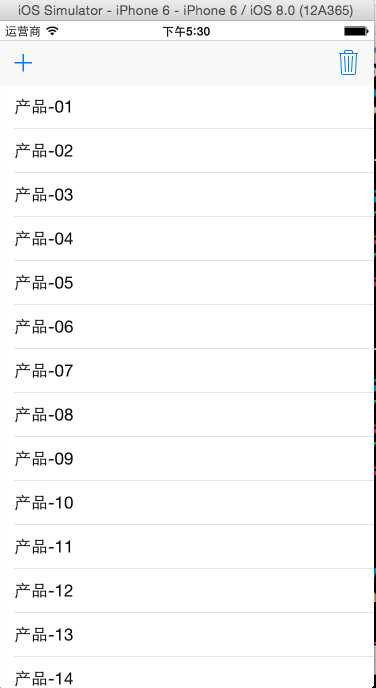 前《=====》后
前《=====》后 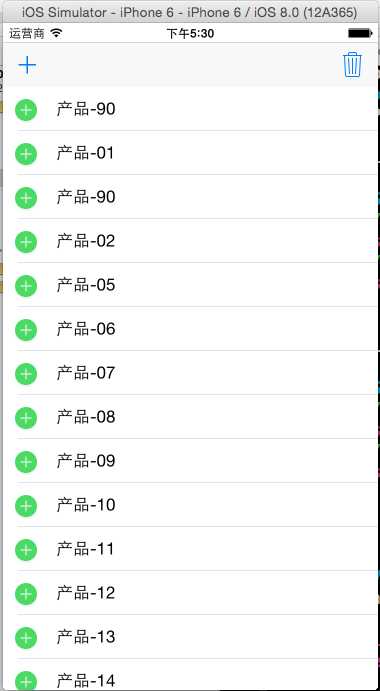
 前<======>后
前<======>后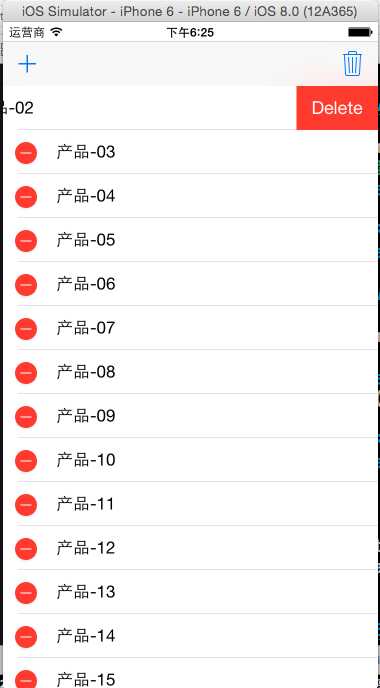
1 #import "ViewController.h"
2 #define ARRAYM_NUM 20
3 @interface ViewController ()<UITableViewDataSource,UITableViewDelegate>
4 @property (weak, nonatomic) IBOutlet UITableView *tableView;
5 @property (strong,nonatomic)NSMutableArray *arrayM;
6 @property (assign,nonatomic)BOOL isDelete;
7 @end
8
9 @implementation ViewController
10 - (IBAction)addClicked:(UIBarButtonItem *)sender {
11 self.isDelete = NO;
12 self.tableView.editing = !self.tableView.editing;
13 }
14 - (IBAction)deleteClicked:(UIBarButtonItem *)sender {
15 self.isDelete = YES;
16 self.tableView.editing = !self.tableView.editing;
17 }
18
19 - (void)viewDidLoad {
20 [super viewDidLoad];
21 //初始化数据
22 self.arrayM = [NSMutableArray arrayWithCapacity:ARRAYM_NUM];
23 for (int i=0; i<ARRAYM_NUM; i++)
24 {
25 NSString *productName = [NSString stringWithFormat:@"产品-%02d",i+1];
26 [self.arrayM addObject:productName];
27
28 //设置tableView的数据源和代理
29 self.tableView.dataSource = self;
30 self.tableView.delegate = self;
31 }
32 }
33
34 #pragma mark -tableView的数据源方法
35
36 //每组多少行
37 -(NSInteger)tableView:(UITableView *)tableView numberOfRowsInSection:(NSInteger)section
38 {
39 return self.arrayM.count;
40 }
41 //设置每一个单元格的内容
42 -(UITableViewCell *)tableView:(UITableView *)tableView cellForRowAtIndexPath:(NSIndexPath *)indexPath
43 {
44 //1.根据reuseIdentifier,先到对象池中去找重用的单元格对象
45 static NSString *reuseIdentifier = @"productCell";
46 UITableViewCell *cell = [self.tableView dequeueReusableCellWithIdentifier:reuseIdentifier];
47 //2.如果没有找到,自己创建单元格对象
48 if(cell == nil)
49 {
50 cell = [[UITableViewCell alloc]initWithStyle:UITableViewCellStyleDefault reuseIdentifier:reuseIdentifier];
51 }
52 //3.设置单元格对象的内容
53 cell.textLabel.text = [self.arrayM objectAtIndex:indexPath.row];
54
55 return cell;
56 }
57
58 //tableView的编辑的处理
59 -(void)tableView:(UITableView *)tableView commitEditingStyle:(UITableViewCellEditingStyle)editingStyle forRowAtIndexPath:(NSIndexPath *)indexPath
60 {
61 if(editingStyle == UITableViewCellEditingStyleDelete)
62 {
63 NSLog(@"要删除第%ld行",indexPath.row);
64 //1.要在数组中删掉相应的元素
65 [self.arrayM removeObjectAtIndex:indexPath.row];
66 //2.做局部的刷新
67 [self.tableView deleteRowsAtIndexPaths:@[indexPath] withRowAnimation:UITableViewRowAnimationMiddle];
68 }
69 if(editingStyle == UITableViewCellEditingStyleInsert)
70 {
71 NSLog(@"要插入第%ld行",indexPath.row);
72 //1.要在数组中插入新的元素
73 [self.arrayM insertObject:[NSString stringWithFormat:@"产品-%02d", arc4random_uniform(100)] atIndex:indexPath.row];
74 //2.做局部的刷新
75 [self.tableView insertRowsAtIndexPaths:@[indexPath] withRowAnimation:UITableViewRowAnimationRight];
76 }
77 }
78
79 -(UITableViewCellEditingStyle)tableView:(UITableView *)tableView editingStyleForRowAtIndexPath:(NSIndexPath *)indexPath
80 {
81 if(self.isDelete)
82 return UITableViewCellEditingStyleDelete;
83 else
84 return UITableViewCellEditingStyleInsert;
85 }
86 @end
1 //设置每一个单元格的内容
2 -(UITableViewCell *)tableView:(UITableView *)tableView cellForRowAtIndexPath:(NSIndexPath *)indexPath
3 {
4 //1.根据reuseIdentifier,先到对象池中去找重用的单元格对象
5 static NSString *reuseIdentifier = @"<#name#>";
6 UITableViewCell *cell = [self.tableView dequeueReusableCellWithIdentifier:reuseIdentifier];
7 //2.如果没有找到,自己创建单元格对象
8 if(cell == nil)
9 {
10 cell = [[UITableViewCell alloc]initWithStyle:UITableViewCellStyleDefault reuseIdentifier:reuseIdentifier];
11 }
12 //3.设置单元格对象的内容
13
14 return cell;
15 }
tableView的编辑模式(删除、插入)分三步处理
1.打开tableView的编辑模式
self.tableView.editing = YES
2.返回单元格的编辑类型
编辑类型三种:none、insert、delete
默认的编辑类型为delete
-(UITableViewCellEditingStyle)tableView:(UITableView *)tableView editingStyleForRowAtIndexPath:(NSIndexPath *)indexPath
3.对单元格进行具体的编辑处理
-(void)tableView:(UITableView *)tableView commitEditingStyle:(UITableViewCellEditingStyle)editingStyle forRowAtIndexPath:(NSIndexPath *)indexPath
1 //tableView的编辑的处理
2 -(void)tableView:(UITableView *)tableView commitEditingStyle:(UITableViewCellEditingStyle)editingStyle forRowAtIndexPath:(NSIndexPath *)indexPath
3 {
4 if(editingStyle == UITableViewCellEditingStyleDelete)
5 {
6 NSLog(@"要删除第%ld行",indexPath.row);
7 //1.要在数组中删掉相应的元素
8 [self.arrayM removeObjectAtIndex:indexPath.row];
9 //2.做局部的刷新
10 [self.tableView deleteRowsAtIndexPaths:@[indexPath] withRowAnimation:UITableViewRowAnimationMiddle];
11 }
12 if(editingStyle == UITableViewCellEditingStyleInsert)
13 {
14 NSLog(@"要插入第%ld行",indexPath.row);
15 //1.要在数组中插入新的元素
16 [self.arrayM insertObject:[NSString stringWithFormat:@"产品-%02d", arc4random_uniform(100)] atIndex:indexPath.row];
17 //2.做局部的刷新
18 [self.tableView insertRowsAtIndexPaths:@[indexPath] withRowAnimation:UITableViewRowAnimationRight];
19 }
20 }
21
22 //返回单元格编辑类型
23 -(UITableViewCellEditingStyle)tableView:(UITableView *)tableView editingStyleForRowAtIndexPath:(NSIndexPath *)indexPath
24 {
25 if(self.isDelete)
26 return UITableViewCellEditingStyleDelete;
27 else
28 return UITableViewCellEditingStyleInsert;
29 }
在tableView中移动单元格的步骤:
1、把tableView的editing设置成YES
2、在返回单元格编辑类型方法时一定要返回none
3、设置单元格能够移动(返回YES)
-(BOOL)tableView:(UITableView *)tableView canMoveRowAtIndexPath:(NSIndexPath *)indexPath
4、进行单元格移动后的处理
-(void)tableView:(UITableView *)tableView moveRowAtIndexPath:(NSIndexPath *)sourceIndexPath toIndexPath:(NSIndexPath *)destinationIndexPath
1 //返回单元格编辑类型
2 -(UITableViewCellEditingStyle)tableView:(UITableView *)tableView editingStyleForRowAtIndexPath:(NSIndexPath *)indexPath
3 {
4 return UITableViewCellEditingStyleNone;
5 }
6 //设置单元格是否能移动
7 -(BOOL)tableView:(UITableView *)tableView canMoveRowAtIndexPath:(NSIndexPath *)indexPath
8 {
9 return YES;
10 }
11
12 //移动单元格时的处理
13 -(void)tableView:(UITableView *)tableView moveRowAtIndexPath:(NSIndexPath *)sourceIndexPath toIndexPath:(NSIndexPath *)destinationIndexPath
14 {
15 //修改数组中的元素的顺序
16 //1.先取出要移动的元素
17 NSString *item = [self.arrayM objectAtIndex:sourceIndexPath.row];
18
19 //2.先把原来位置的元素删掉
20 [self.arrayM removeObjectAtIndex:sourceIndexPath.row];
21
22 //3.在新的位置上重新插入
23 [self.arrayM insertObject:item atIndex:destinationIndexPath.row];
24 }
标签:
原文地址:http://www.cnblogs.com/daxiong520/p/4915980.html